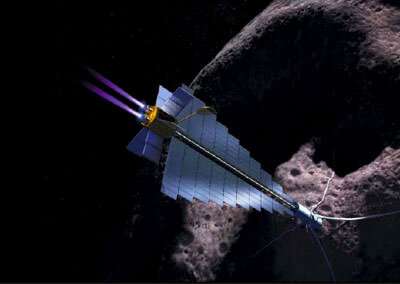Since many asteroids are "rubble piles," such direct kinetic impactors or nuclear explosions would at best knock apart some of the larger parts of the object, but at worst, it would create multiple chaotic trajectory objects that could impact the Earth at even higher speeds.
Designed to avoid such outcomes, gravity tractors come in one of four varieties. The stationary version parks a relatively heavy probe next to an object and slowly pulls it into a different trajectory. A halo orbit version is a probe that slowly circles the object in a pattern designed to push it in a specific direction. These first two techniques would use traditional chemical rockets to reach their targets, but a third version—a solar sail-equipped gravity tractor—could slowly move into position to allow the probe to nudge the object out of the way. Finally, a constellation of probes could work together to push an object into a new path.
Dr. Ketema's work suggests using a modified version of the stationary and halo orbit types. The new orbit is called "restricted Keplerian motion," which involves moving a probe back and forth on a specific side of an asteroid to try to force it as much as possible in a particular direction. Dr. Ketema initially suggested this solution in a 2017 paper, and he has recently released new research that improves upon the orbit by decreasing the weight required in the probe.
To do this, he turned to mathematical optimization. In optimization problems, there are goals and constraints. In this case, there was one goal (moving the asteroid out of a hazardous orbit) and three constraints: 1) Don't directly impact the asteroid, 2) Don't hit the asteroid with thrusters, 3) Give enough time for the gravity tractor to do its work. Best estimates for that third constraint seem to be around ten years. Such long time horizons show the importance of early detection in asteroid defense strategies.
That time factor is also vital due to the amount of time it would take for a gravity tractor to reach an asteroid. Since the weight of the probe is an essential factor in the tool's effectiveness, the more fuel that burns up with it (i.e., if the probe had to arrive in place quickly), the less effective it will be at pulling the asteroid off course.
To test his optimization technique, Dr. Ketema simulated his new style gravity tractor on an existing asteroid—2007 VK184. While it will pass near to Earth soon, this asteroid will not hit it. But by placing a gravity tractor next to it about ten years out, calculations show that it could be moved into an even safer orbit.
Even with this real-life simulation, there are still a few kinks to work out. First, gravity tractors don't work well on larger objects since their effectiveness depends entirely on how their size compares to the object they are trying to move. Luckily, most larger asteroids on unsafe orbits are already closely tracked and don't appear to be heading for Earth anytime soon. A more specific problem to the modeling done in the paper is that asteroids don't have a spherical gravitational field, making it harder to calculate the best orbit to deflect them onto to provide a safer course.
Any asteroid that would potentially post such a hazard would be very carefully studied, though. And any probe could likely have a gravitometer to study the object's gravitational field in real-time and allow it to adjust its orbit accordingly. But any advantage humans would get after this potentially extraordinarily devastating hazard is well worth the time spent to develop it.
Explore further

